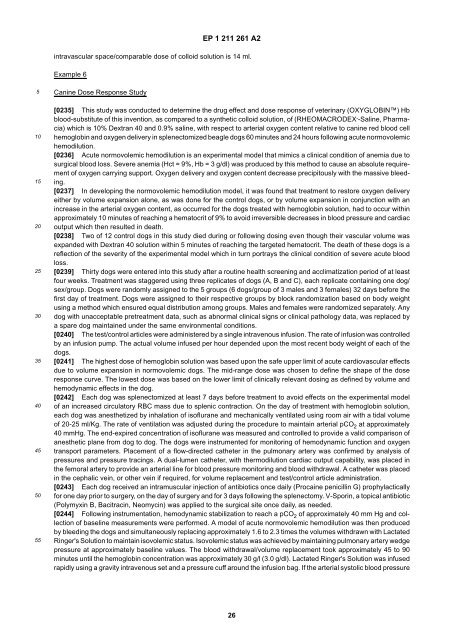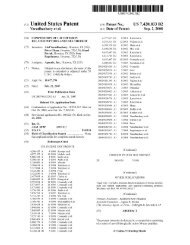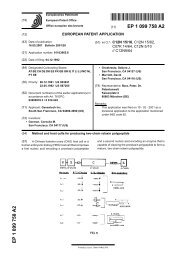EP 1 211 261 A2
EP 1 211 261 A2
EP 1 211 261 A2
You also want an ePaper? Increase the reach of your titles
YUMPU automatically turns print PDFs into web optimized ePapers that Google loves.
<strong>EP</strong> 1 <strong>211</strong> <strong>261</strong> <strong>A2</strong>intravascular space/comparable dose of colloid solution is 14 ml.Example 6510152025303540455055Canine Dose Response Study[0235] This study was conducted to determine the drug effect and dose response of veterinary (OXYGLOBIN) Hbblood-substitute of this invention, as compared to a synthetic colloid solution, of (RHEOMACRODEX - -Saline, Pharmacia)which is 10% Dextran 40 and 0.9% saline, with respect to arterial oxygen content relative to canine red blood cellhemoglobin and oxygen delivery in splenectomized beagle dogs 60 minutes and 24 hours following acute normovolemichemodilution.[0236] Acute normovolemic hemodilution is an experimental model that mimics a clinical condition of anemia due tosurgical blood loss. Severe anemia (Hct = 9%, Hb = 3 g/dl) was produced by this method to cause an absolute requirementof oxygen carrying support. Oxygen delivery and oxygen content decrease precipitously with the massive bleeding.[0237] In developing the normovolemic hemodilution model, it was found that treatment to restore oxygen deliveryeither by volume expansion alone, as was done for the control dogs, or by volume expansion in conjunction with anincrease in the arterial oxygen content, as occurred for the dogs treated with hemoglobin solution, had to occur withinapproximately 10 minutes of reaching a hematocrit of 9% to avoid irreversible decreases in blood pressure and cardiacoutput which then resulted in death.[0238] Two of 12 control dogs in this study died during or following dosing even though their vascular volume wasexpanded with Dextran 40 solution within 5 minutes of reaching the targeted hematocrit. The death of these dogs is areflection of the severity of the experimental model which in turn portrays the clinical condition of severe acute bloodloss.[0239] Thirty dogs were entered into this study after a routine health screening and acclimatization period of at leastfour weeks. Treatment was staggered using three replicates of dogs (A, B and C), each replicate containing one dog/sex/group. Dogs were randomly assigned to the 5 groups (6 dogs/group of 3 males and 3 females) 32 days before thefirst day of treatment. Dogs were assigned to their respective groups by block randomization based on body weightusing a method which ensured equal distribution among groups. Males and females were randomized separately. Anydog with unacceptable pretreatment data, such as abnormal clinical signs or clinical pathology data, was replaced bya spare dog maintained under the same environmental conditions.[0240] The test/control articles were administered by a single intravenous infusion. The rate of infusion was controlledby an infusion pump. The actual volume infused per hour depended upon the most recent body weight of each of thedogs.[0241] The highest dose of hemoglobin solution was based upon the safe upper limit of acute cardiovascular effectsdue to volume expansion in normovolemic dogs. The mid-range dose was chosen to define the shape of the doseresponse curve. The lowest dose was based on the lower limit of clinically relevant dosing as defined by volume andhemodynamic effects in the dog.[0242] Each dog was splenectomized at least 7 days before treatment to avoid effects on the experimental modelof an increased circulatory RBC mass due to splenic contraction. On the day of treatment with hemoglobin solution,each dog was anesthetized by inhalation of isoflurane and mechanically ventilated using room air with a tidal volumeof 20-25 ml/Kg. The rate of ventilation was adjusted during the procedure to maintain arterial pCO 2 at approximately40 mmHg. The end-expired concentration of isoflurane was measured and controlled to provide a valid comparison ofanesthetic plane from dog to dog. The dogs were instrumented for monitoring of hemodynamic function and oxygentransport parameters. Placement of a flow-directed catheter in the pulmonary artery was confirmed by analysis ofpressures and pressure tracings. A dual-lumen catheter, with thermodilution cardiac output capability, was placed inthe femoral artery to provide an arterial line for blood pressure monitoring and blood withdrawal. A catheter was placedin the cephalic vein, or other vein if required, for volume replacement and test/control article administration.[0243] Each dog received an intramuscular injection of antibiotics once daily (Procaine penicillin G) prophylacticallyfor one day prior to surgery, on the day of surgery and for 3 days following the splenectomy. V-Sporin, a topical antibiotic(Polymyxin B, Bacitracin, Neomycin) was applied to the surgical site once daily, as needed.[0244] Following instrumentation, hemodynamic stabilization to reach a pCO 2 of approximately 40 mm Hg and collectionof baseline measurements were performed. A model of acute normovolemic hemodilution was then producedby bleeding the dogs and simultaneously replacing approximately 1.6 to 2.3 times the volumes withdrawn with LactatedRinger's Solution to maintain isovolemic status. Isovolemic status was achieved by maintaining pulmonary artery wedgepressure at approximately baseline values. The blood withdrawal/volume replacement took approximately 45 to 90minutes until the hemoglobin concentration was approximately 30 g/l (3.0 g/dl). Lactated Ringer's Solution was infusedrapidly using a gravity intravenous set and a pressure cuff around the infusion bag. If the arterial systolic blood pressure26




